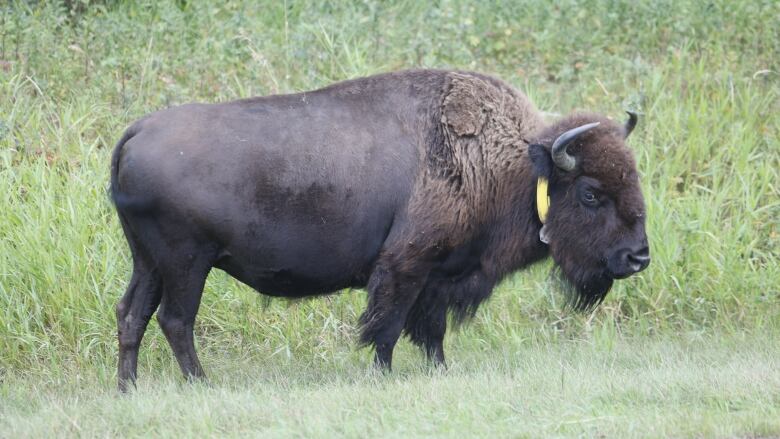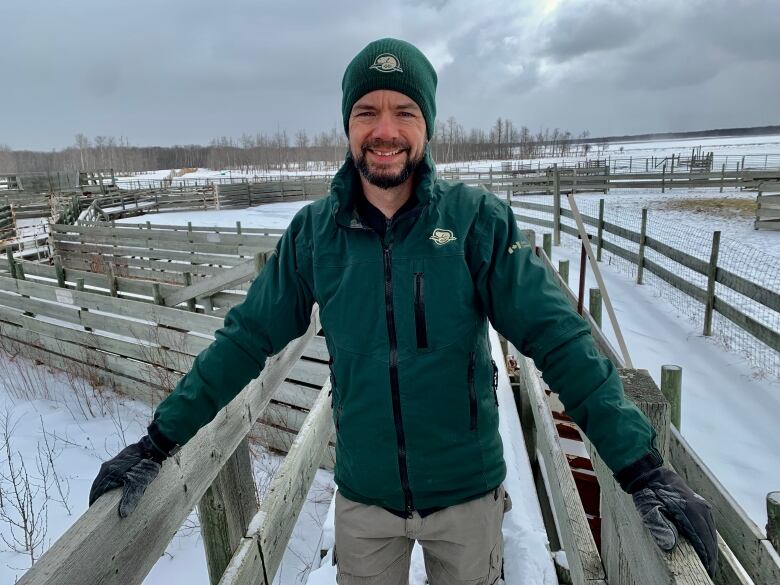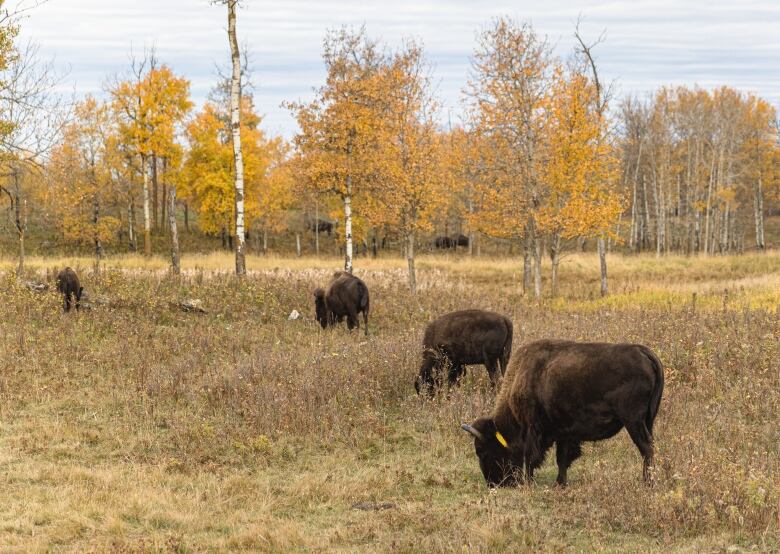Smart collars help Elk Island National Park staff learn where and why the buffalo roam
'The information we get from those collars lets us understand how the bison are using the park'

Elk Island National Park staff are equippingbison withsmart collars to find out where and why the buffalo roam.
The national park, 35 minutes east of Edmonton, is home to about1,000 wood and plains bison. Tenfemale animals from each herd were randomly selected to wear the high-tech trackers, says Jonathan DeMoor,Elk Island National Park ecologist.
"Our GPS collars record a location every two hours and they transmit that data via satellite once a day so those maps are a snapshot of each point from one day," DeMoor says.

Which means while park staff may not have up-to-the-minute locations, they do have a pretty good idea of where the bisonspend most of their time.
That intel is shared on a map in the visitor centreto "increase your odds of finding the herd,"DeMoor says.
Often the herd isjust out of sight, over a hill or tucked into a stand of trees, he says.
"The information we get from those collars lets us understand how the bison are using the park, what kind of habitats they're using, and the difference in different seasons in terms of where they head."
The collars also revealsomething of the herd'ssocial scene.
"It's one large herd that breaks off into little groups and then they come back and then mingle up and they split off into different groups," DeMoor says.
You can see more from Elk Island National Park on this week's Our Edmonton on Saturday at 10 a.m., Sunday at noon and 11 a.m. Monday on CBC TV and CBC Gem.
The collarsalso have an accelerometer,a Fitbit-like device, built in to recordhow much the bison move.
Video verifies naptime
The park has been collecting data from the collarssince 2016, but recently one of the animals was also equipped with acamera.
"It's actually a radio collar combined with a video collar on the bottom of it," says Brian Eaton,chair of theFriends of Elk Island Society (FEIS), which purchased the $5,000 camera.
The camera, attached tothe five-year-old bisonnicknamed Feisty,records20 seconds of video every hour during the day, Eaton says.
After a year of wearing it around the collar was recently retrieved and the camera sentto the Germanmanufacturer where the video is now beingdownloaded.

The bison body cam has predictably revealed alot of walking and grazing but there are also videosof Feisty watching the traffic go by,wallowing in dirt and taking naps in the tall grass.
Matching these snippets with the location data gives researchers a glimpse into herdbehaviour.
"Then you can say, she's moving pretty fast, she's probably running," Eaton says. "We don't know that for sure, now we can look at this video clips and relate it to what her accelerometer data looks like and they can actually use that to calibrate what they're getting from other animals as well."
- Critter candid cameras revealing inhabitants east of Edmonton
- Destructive, invasive wild pigs in Alberta have breached national park boundary for 1st time
- Outdoor gems map: 50 sizzlin' sites to skate, ski, stargaze in and around Edmonton
Research and conservation
Bison are North America's largest land mammal. Millions once dotted thecontinent from Alaska to Mexico, before they huntedto near extinction by early settlers.
The Canadian government purchased one of the remaining herds and, between 1907 and 1912,shipped more than 700animalsby train to Elk Island.
This 194-square-kilometre space is the country's largest fully enclosed national park with a mix grasslands, aspen andboreal forest.

Right now a few dozen wood bison are in a penwaiting to be moved toAlaska.
"To us, they're deities out there, placed in different sanctuaries throughout the universe,"says Jerry Saddleback, Samson Cree Nation Elder, on a recent visit to the park.
For his people observing the sacred animals is nothing new, he says.
"We had our own traditional people who knew how to track themthrough buffalo trails, ...which direction they would be travelingand where our [encampment]would be ideally located."
Saddlebacksaysbeing near the animals at the park is rejuvenating.
"It gives you a certain level of inspiration;it touches your soul."














_(720p).jpg)


 OFFICIAL HD MUSIC VIDEO.jpg)
.jpg)



























































































